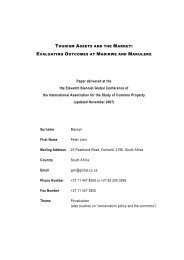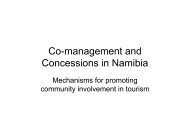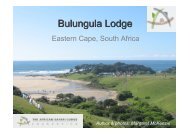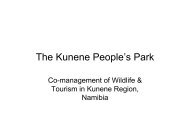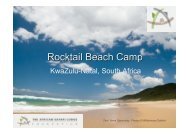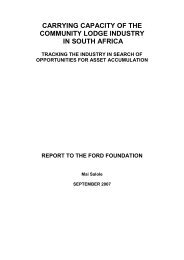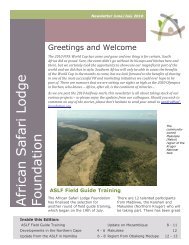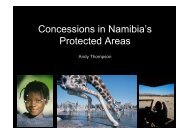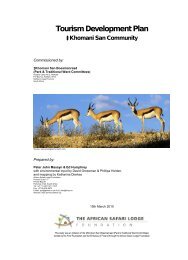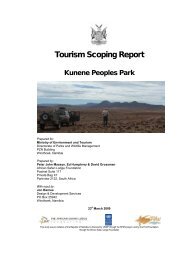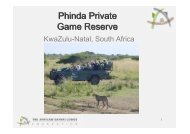socio-economic research on manda wilderness, lago district, niassa ...
socio-economic research on manda wilderness, lago district, niassa ...
socio-economic research on manda wilderness, lago district, niassa ...
Create successful ePaper yourself
Turn your PDF publications into a flip-book with our unique Google optimized e-Paper software.
MW has increased the recogniti<strong>on</strong> of its surrounding communities and strengthened their links with the<br />
external world. The communities have gained substantial experience of liaising with an ecotourism<br />
company, local NGOs, government officials, <str<strong>on</strong>g>research</str<strong>on</strong>g>ers and internati<strong>on</strong>al volunteers. This experience,<br />
combined with their greater organisati<strong>on</strong>al capacity, has increased c<strong>on</strong>fidence to pro-actively engage<br />
with outsiders and they are gaining greater recogniti<strong>on</strong> from policy-makers, d<strong>on</strong>ors and potentially other<br />
tourism companies.<br />
The impact of changes in social capital <strong>on</strong> sustainable livelihoods is hard to measure. Yet the overall<br />
increase in the organisati<strong>on</strong>al strength of isolated communities surrounding Manda Wilderness should<br />
positively impact <strong>on</strong> livelihoods. Rural households need effectively functi<strong>on</strong>ing community instituti<strong>on</strong>s<br />
to manage and mediate relati<strong>on</strong>s between households, and the land, natural resources, social networks<br />
and informal markets <strong>on</strong> which they all depend and to represent the community’s interests to others.<br />
4.2.3 Impact <strong>on</strong> Activities and Strategies<br />
Tourism complements or c<strong>on</strong>flicts with existing activities of local people and the impact <strong>on</strong> assets can<br />
influence the activities people do. One of the most important ways in which MWL supports other<br />
activities is that it strengthens households’ productive capacity by increasing skills and providing cash<br />
for investment (as discussed above). The new skills gained by the lodge staff, farm employees, village<br />
committee and UMOJI members can be transferred to other activities. These positive impacts of<br />
enhanced skills and investment potential are of most benefit to the relatively better-off households, who<br />
are more likely to get jobs and have a surplus for investment.<br />
Tourism and c<strong>on</strong>servati<strong>on</strong> c<strong>on</strong>flicts with existing activities in two key ways: by reducing access to<br />
natural resources and potentially exacerbating wildlife damage to crop producti<strong>on</strong> which is the staple<br />
activity. Setting aside a large area for wildlife and tourists, reduces access to natural resources for<br />
other activities. Loss of access to plant resources is more of a c<strong>on</strong>cern for poor households, and<br />
particularly women, who are more dependent <strong>on</strong> harvesting a range of natural resources such as<br />
firewood, bamboo and grass for fuel, building and income-generati<strong>on</strong> (e.g. selling firewood and weaving<br />
materials to make mats and rope for sale). An aquatic reserve would also reduce access to fish in<br />
Mchenga Nkwichi bay.<br />
The area was severely depleted of game during col<strong>on</strong>ialism and wars and subsistence hunting<br />
c<strong>on</strong>tinues illicitly further inland. However, an increase in wildlife was highlighted by Mandambuzi village<br />
and attributed to MW’s sensitisati<strong>on</strong> <strong>on</strong> c<strong>on</strong>servati<strong>on</strong>. Wildlife causes significant crop damage and to a<br />
lesser extent presents risks to livestock and humans. Interviewed villagers identified the following<br />
wildlife as causing problems:<br />
Wild Animal Number of Interviewees<br />
Babo<strong>on</strong> 100%<br />
Antelope 53%<br />
Porcupine 28%<br />
Hippo 25%<br />
Vervet m<strong>on</strong>key 20%<br />
Elephant 13%<br />
Wild pig 15%<br />
Leopard 10%<br />
Jackal 8%<br />
Hyena 3%<br />
Crocodile 3%<br />
Every survey resp<strong>on</strong>dent (40) experienced crop raiding and the most comm<strong>on</strong> problem is babo<strong>on</strong><br />
troops. Populati<strong>on</strong> numbers and species of game vary in different locati<strong>on</strong>s. A larger number and type<br />
of wildlife cause crop damage inland, for example, elephant and hippo are seen in Mandambuzi but not<br />
in Mala and Mbueca. However, many lakeshore interviewees (17) reported problems with ungulates<br />
(antelopes) in the dry seas<strong>on</strong> such as kudu. Livestock producti<strong>on</strong> is goat and chicken rearing and 2<br />
20



